Nanoxia Deep Silence 1 Case Review: You Asked For It, You Got It
by Dustin Sklavos on November 27, 2012 12:01 AM EST- Posted in
- Cases/Cooling/PSUs
- quiet
- ATX
- Nanoxia
Noise and Thermal Testing, Overclocked
Stock results for the Nanoxia Deep Silence 1 with the case fans set to low were admittedly pretty poor outside of the noise levels, and that made me nervous about testing it with the testbed overclocked. For what it's worth, the DS1 was able to run our overclocked testbed, but I wouldn't be comfortable with the low-90s temperatures that the CPU reached. You'll see, though, that if you let the fans stretch their legs a little, Nanoxia's design starts to come into its own again.



This is the first time keeping the chimney open has notably improved cooling performance, but the DS1 is starting to have trouble competing with the performance-oriented enclosures and is only able to tie the Ghost and 550D. Everything else runs reasonably cool, though.


Fan speeds are much more competitive, though. The low fan setting has a hard time keeping up, but the high fan setting proves the case has a healthy amount of fight in it.

And then the other haymaker. Once again the DS1 is able to meet or beat the other silent cases while offering competitive if not superior performance. This isn't the coolest running case, but it's the quietest. Out of our high end cases, the only one that can produce comparable acoustic performance is NZXT's Phantom 820, a case that's going to cost at least twice as much.










75 Comments
View All Comments
Grok42 - Thursday, November 29, 2012 - link
Sounds like an interesting concept. Can you give an example of a case that does this? My pet peeve are external bays but I also think internal ones could be designed better and have been trying to find someone doing something new in this area.Death666Angel - Tuesday, November 27, 2012 - link
Don't you guys have import in the US? I can buy stuff from all over the world and have it shipped to my door step in Germany. :Dkaragiosis - Tuesday, November 27, 2012 - link
Just a small errata. On the noise level chart (overclocked) the labels for the fans at low and high speed should be swappedDustin Sklavos - Tuesday, November 27, 2012 - link
Nope, it's correct as posted. The higher fan setting for the case improves airflow so much that the CPU and GPU fans don't spin as high.dehemke - Tuesday, November 27, 2012 - link
Where are the Antec Performance One series in the comparison charts?This thing looks like a P18x/28x inspired design, I'd like to see how well it stacks up against those.
I'm still running a jet black P180 and a Mirror finish P182, but I had to do some modifications to get them to play nicely with the new longer PSU's and video cards.
Is this the right successor?
jjwa - Wednesday, December 12, 2012 - link
I am still running my main rig in a P180 :). It rocks. And it's used for gaming, playing server and everything else at the same time. While overclocked. The only problem I have now is that I have put so many HDDs into it (replacing the upper stock HDD cage) that I reduced it's air intake too far :(.mascotzel - Tuesday, November 27, 2012 - link
What is the high low significance in the review?Galcobar - Tuesday, November 27, 2012 - link
It's explained in the first paragraph of the Noise and Thermal Testing section, just above the charts.mascotzel - Wednesday, November 28, 2012 - link
so why are the fans on low noisier than the same fans on high in the charts?flyingpants1 - Wednesday, November 28, 2012 - link
In my opinion, the only sources of noise in most modern computers should be two 140mm+ fans: The CPU fan and the PSU fan. The 140mm CPU fan on a 120mm heatsink can be ducted to the rear exhaust port - no need for case fans. SSDs make no noise. Hard drives make no noise when idle, and when running they require no active cooling, see the Google hard drive study. Integrated GPUs obviously don't need extra cooling.It's possible to eliminate the PSU fan by using a fanless PSU, but this limits your GPU choices. As for high-end GPUs like a GTX680, one could easily imagine an aftermarket GPU heatsink with a 140mm which spins at inaudible speeds on idle.
Combine all that with a quiet case and an inch of soundproofing stuff, and your computer will be literally inaudible by human ears when idle.